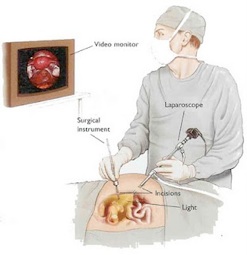What is Keyhole Surgery?
Laparoscopic inguinal hernia repair uses an instrument called a laparoscope. Between two and four small incisions are made through the abdominal wall through which are passed the laparoscope (a thin telescope with a light on the end) and surgical  instruments into the abdomen. The incisions are small, so the whole technique is often called keyhole surgery. (Conventional surgery is called open surgery.)
instruments into the abdomen. The incisions are small, so the whole technique is often called keyhole surgery. (Conventional surgery is called open surgery.)
It is also often referred to as minimally invasive or minimal access surgery.
The hernia is then viewed from inside the abdomen, from the other side of the abdominal wall.
The abdominal cavity is inflated with carbon dioxide gas to give the surgeon space to work inside the patient and the actual operating is done remotely with long instruments.
The hernia defect or hole is covered with mesh from within the abdomen and staples commonly fired through it into the muscle tissue in order to fix it as a patch.
Problems
When done well, by well-trained and experienced surgeons in appropriately selected cases, the results of keyhole inguinal hernia repair can be very good and where appropriate we use it ourselves.
The problem is that well-trained surgeons who are experienced in laparoscopic surgery and specialise in hernia repair are few and far between. The consequences of a poorly carried out keyhole repair can be serious.
The advantage put forward for laparoscopic surgery is that no large cut is made on the abdomen so in theory there is less post-operative pain and a faster return to normal activities. For example, with major bowel surgery, where large cuts have traditionally been made, the laparoscopic option is a good one.
But for inguinal hernia repair the incision for our described open local anaesthetic repair is small anyway, particularly in the hands of surgeons who specialise, so the difference in that regard is not at all significant.
Pain after Keyhole Surgery
In practice and depending upon how it is performed, you can get quite a lot of pain after a laparoscopic inguinal hernia repair, because the pain does not come from the skin cut anyway. The pain is more likely to be related to the fact that the deep tissues have been cut and pulled, and staples may have been used to fix the mesh.
Disadvantages of Keyhole Hernia Surgery
- It is technically demanding for the surgeon. What that really means is that its difficult to learn and difficult to do well. He has to practice a great deal and perform a large number to become really good at it.
- Due to the nature of operating by using a 2D video image of the site rather than proper 3D visualisation there is the risk of major organ damage (blood vessel, bowel and bladder).
- Keyhole repairs have to be done under general anaesthesia. That carries risks on its own and certainly not so good if you are elderly or have other medical conditions.
So when would Keyhole Hernia Surgery be recommended?
- If there has been a previous failed open repair, particularly if mesh was used ‘unsuccessfully’ or perhaps, inexpertly.
- In certain incisional hernia cases where laparoscopy is deemed more appropriate
- In certain cases involving hernia on both sides (a bilateral hernia) and both are to be repaired at the same time
- On a per-case basis where it is felt that the balance of factors indicate that laparoscopy would be the better option
NICE has made the following recommendations about the use of laparoscopic surgery to treat inguinal hernia (2004) http://guidance.nice.org.uk/TA83
